
|
Sale 69
The May Pre-Long Beach Auction
| Hawaii Coins - Forsythe Collection |
| |
| |
| Lot |
Photo |
Description |
Realized |
Lot 1853 |
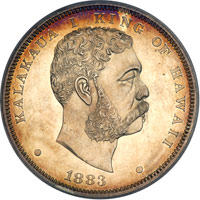 |
1883 Hawaiian Dollar. PCGS graded Proof 63 Cameo CAC Approved. In a new secure plus holder. Light golden toning. Only 26 struck in Proof. This is an extremely rare example of the Akahi Dala, or One Dollar (same weight and fineness as the U.S. Morgan silver dollars of the day). Only slightly more than two dozen were struck in Proof for the Hawaiian Government from dies prepared at the Philadelphia Mint. Curiously, the copper pattern issues from the same dies for Hawaiian coinage were prepared and coins struck at the San Francisco Mint, not Philadelphia. The dies were engraved by Charles E. Barber. Months after the transaction was completed, it turns out that Claus Spreckels, the sugar baron, who used his influence to have the coins made for the Hawaiian Government, had clandestinely pocketed a $100,000 to $150,000 "seignorage" profit on the transaction, much to the annoyance of the government officials. When his malfeasance was discovered, there was little they could do about it besides fume.
We note some almost invisible hairlines in the fields, accounting for the still very choice grade. The devices, as on the other example in the sale, are all supremely sharply struck and well frosted, giving everything its cameo appearance. Toned deepest at the rim with warm almost-amber brown, smoothing out to lovely light golden color within, nothing untoward, unusual, or disconcerting to describe in the way of detractions. Quite the contrary, the coin is outstanding! Struck in .900 Fine silver with a reeded edge, which is visible in the NGC holder. Long known as a classic rarity, and certain to be the highlight of any specialized Hawaiian collection.
Some time after the coins were produced, the original dies (obverses only) were defaced with chisel marks and now reside in the Hawaii State Archives in Honolulu (small building next to the popular tourist attraction of Iolani Palace.) Few have ever seen them but they can be viewed upon request. They are not on display. Your cataloger had the good fortune to view them at the Archives in the 1970s. They are covered in protective grease to retard oxidation. Don Medcalf, in his "Hawaiian Money Standard Catalog" second edition, pictures a set of cancelled dies on page 39 for those interested. Scant auction records are recorded for Proof Hawaiian dollars, they simply sell too infrequently with only 26 made. Pop 1; 1 finer in 64CAM. (PCGS #415929).
Note: According to Jacob Adler ("Coinage of Hawaii", co-authored with Abe Kosoff):
"The Kalakaua coinage of 1883 resulted from an adroit combination of two apparently unrelated laws: The Coinage Act of 1880 and the National Loan Act of 1882. The coinage act provided that the Minister of Finance could buy gold and silver bullion "with any moneys which may from time to time be in the Treasury." With the bullion he could have gold coins minted of certain specified denominations and "Silver Coins of the value of One Dollar, Fifty Cents, Twenty-five Cents and Twelve and one-half Cents." All coins were to be of the same weight and fineness as coins of the United States.
"The National Loan Act provided for the lending of $2,000,000 for specific purposes, the most important being encouragement of immigration and agriculture, and construction of roads, bridges and government buildings. Under the law, the proceeds were not to be used for current expenses of the government. Bonds under the loan act were to be issued at not less than par, with an interest rate of not more than six per cent a year. Principal and interest were to be payable "in United States gold coin or its equivalent."
"Soon after the loan act was signed there were rumors that [sugar baron Claus] Spreckels would take all of the bonds. This was "denied authoritatively." Emphasizing the kingdom�s lack of credit, the Bulletin said: "The ways and means of floating the Two Million Loan were being discussed on the beach the other day and nearly everyone decried it as impossible." For several months requests for tenders up to $500,000 ran in the Honolulu newspapers without result. Unsuccessful efforts were also made to float part of the loan in San Francisco.
"Just when [Finance Minister Walter Murray] Gibson hit upon the combination of the coinage and loan acts as the solution to the financial troubles of the government is not entirely clear. Despite official denials, the thought that Spreckels would lend the money was an early one.".
Estimated Value $20,000 - 23,000.
The Forsythe Collection.
View details and enlarged photos
| Realized
$42,550 |
Lot 1854 |
 |
1883 Hawaiian Dollar. NGC graded Proof 62+Cameo CAC Approved. Mostly white with a hint of gold toning near the edges a beautiful cameo two-toned Proof. Only 26 struck. Virtually ice-white devices spread glinting beams of light in every direction, the dies having been carefully made to impart a frosted relief. Proofs of both American coins and Hawaiian coins in the 1880s were struck on the mint's powerful hydraulic press, which gave a unique "squeeze" on the dies. This imparted all of the deepest design from the dies onto the struck planchet. As carefully made as this coin is, it is also covered with mint bloom from the mirror fields to the aforementioned frosted devices, bidders will want to make a special note of the coin's detail. Clockwork precision seen in all areas. A few light hairlines here and there mainly account for the grade; also. if you have never owned a Hawaiian Proof, purchase of this silver dollar will be a luxurious indulgence. Pop 1; 2 finer, 1 in 63, 1 in 65+.
Note: on the reverse of the Silver Dollar only occurs the entire Hawaiian Coat of Arms with a shield on a mantle of ermine (?) and all the royal heraldry within and around. In the upper left and lower right quadrants of the main shield there are two objects that look like a child's helium-filled balloon on a rod. These are tabu-sticks, or Puloulou sticks to use the proper Hawaiian word. (Pronounced Poo-low-oo-low-oo.) Readers may find this description from 129 years ago helpful (from the American Journal of Numismatics, October 1883, piece):
…a " puloulou," or tabu stick, proper. This stick was a long rod, with a ball of "tapa" cloth at its top the white native cloth, prepared from bark. In former days, this staff with the cloth attached, and carried by one of the king's retainers, or by the followers of a high chief, had a peculiar significance. When the "puloulou " was left at the door of a native house it indicated that royalty was within, and it was death to enter, or pass it. When displayed at the four corners of a field, it signified that the land enclosed was appropriated by the chief who had placed them, and the same penalty followed any trespass. On the arms it alludes to the sanctity or inviolability of the government of the kingdom.
[ed. In those idyllic pre-Cook days, if a commoner even stepped on the shadow of a Royal elite, the sentence was death, usually by strangulation with a rope as depicted in some of the late 18th century prints from copper-plate etchings.].
Estimated Value $18,000 - 20,000.
The Forsythe Collection. Possibly Ex Edwards H. Metcalf Collection Feb 1976 Lot 1212 Superior Auction; Ron Russell; Goldbergs "The 9/09 Hawaii Collection"; present owner.
View details and enlarged photos
| Realized
$26,450 |
Lot 1855 |
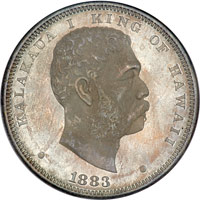 |
1883 Hawaiian Dollar. NGC graded MS-68. The finest known mint state Hawaiian dollar. Attractive, uniform toning and boldly struck. The Hawaiian coinage striking took place at the old Gray Lady Mint in San Francisco in 1883. In 1854, the San Francisco Mint opened its doors and began converting miners' gold into coins. In 1874 it moved to an imposing new facility, with walls of stone, resembling an ancient Greek temple where the Hawaiian coinage was made.
The Mint's production of coins was uninterrupted for 32 years, until the disastrous earthquake of 1906. Because the gas works were partially destroyed, operations stopped temporarily. But the beautiful, solidly constructed Mint building survived both the earthquake and the ensuing firestorm. Coinage continued in this building until 1937, when Mint workers moved to a larger, more modern facility, the present United States Mint at San Francisco.
This Finest Known example of the Hawaiian Dollar is immaculately preserved since the time of issue, with antique silver-gray surfaces. All areas display just the slightest hint of light smoky gold color in the fields. An exacting strike imparts complete sculpture to the design elements, including all the fine detail in the hair above the King�s temple and on his beard; the detailed reverse is also a delight for the numismatist with a magnifying glass and a directional light. Satin luster complements these attributes, all of which combine the result into a sense of elegant eye appeal.
Discussions of Heraldry in coin design have passed, like no-longer circulating words themselves, into desuetude. The modern reader's vision tends to lose focus. But thanks to a copy of the October 1883 issue of "The American Journal of Numismatics" we present a concise description of the reverse design of the famous Hawaiian silver dollar issue in the language of the late 19th century scholar. Readers have our consent to have a dictionary on their lap or fired up on a iPhone:
"The arms are quarterly, 1 and 4, barry of eight, arranged argent, gules, and azure, the bar in base being gules (the eight bars allude to the eight inhabited islands, and are arranged as the stripes in the national flag, in order of color); 2 and 3, argent," a " puloulou," or tabu stick, proper. This stick was a long rod, with a ball of "tapa" cloth at its top the white native cloth, prepared from bark. In former days, this staff with the cloth attached, and carried by one of the king's retainers, or by the followers of a high chief, had a peculiar significance. When the "puloulou " was left at the door of a native house it indicated that royalty was within, and it was death to enter, or pass it. When displayed at the four corners of a field, it signified that the land enclosed was appropriated by the chief who had placed them, and the same penalty followed any trespass. On the arms it alludes to the sanctity or inviolability of the government of the kingdom. The shield has for supporters two natives, in their old costume, the dexter holding a spear and the sinister the "kahili," or feather-topped staff, which was the badge of chief rank. An escutcheon of pretence bears gules, a fan (?) surmounted by two spears in saltire. This escutcheon is a portion of the royal arms, and does not, we are informed, pertain especially to the present ruler. Around the arms is the beautiful and poetic national motto UA MAU KE EA OKA AINA I KAPONO, signifying, "The life of the land is established in righteousness." On the left of the coat of arms is the numeral 1, and on the right D, and underneath AKAHI DALA, both meaning, "one dollar." At the bottom of the shield is the cross of an Order instituted by Kalakaua."
In closing, having released your breath from such a verbose undertaking, now is the time to grab it and take it back in, for the bidding on this remarkable Finest Known Hawaiian Dollar is sure to beat all records. Come to the sale prepared. Take note of the competition. It will be there on every side of you. For this coin tops all others in its denomination. One for the history books. Pop 1; none finer at NGC (PCGS # 10995) .
Historic Note: Samuel Mills Damon was born in Honolulu on March 13, 1845. He became a wealthy land owner in the Islands. After S. M. Damon died July 1, 1924, his estate (then estimated worth over US $250 million, a king�s ransom at the time) was left in trust to his grandchildren. At one time it was the fourth largest private landowner of Hawaii. In 2006 his coin collection alone was auctioned off for $3,884,000 by Doyle New York. It included an 1876 proof set from the US centennial as well as a magnificent collection of Hawaiian coins and paper money, of which this MS68 1883 Dollar is one of the linchpins.
Estimated Value $300,000 - 325,000.
Ex: S.M. Damon Collection; The Forsythe Collection.
View details and enlarged photos
Check results on similar lots
| Unsold |
Lot 1856 |
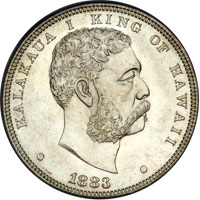 |
1883 Hawaiian Dollar. PCGS graded MS-65 CAC Approved. In a new secure plus holder. Pop 10; 5 finer, 4 in 66, 1 in 67. Well struck and fully untoned. Brilliant with silver like ice -- clear silvery and with full blossom from the dies; the examiner's eye will travel over the surface of this appealing coin to find everything is in order, everything delightfully original and appealing. Among the rest of the characteristics, the coin displays clear-cut devices from having been giving a full, hard strike by the dies (PCGS # 10995) .
Note: King Kalakaua, whose profile dominates the 1883 silver coinage, was a highly educated man with a historian's perspective, a studied politician's aptitude, the usual manly faults (gambling, hard liquor, unseemly political cronies), but also he was a gifted writer and diplomat who, with his wife Queen Kapiolani, wrote lyrics to favorite Hawaiian songs. His "Hawaii Ponoi" is today the Hawaiian State Anthem. Kalakaua's sister, Liliuokalani, who would take the thrown upon his death in 1891, wrote the lyrics to the world-famous "Aloha Oe."
Estimated Value $13,000 - 15,000.
The Forsythe Collection.
View details and enlarged photos
Check results on similar lots
| Realized
$31,050 |
Lot 1857 |
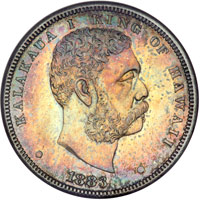 |
1883 Hawaiian Dollar. NGC graded MS-65 CAC Approved. Old Holder. Rainbow toning on both sides. One of the most impressive examples of this grade known, with extraordinary surfaces for a coin of this period. Hawaiian Dollars are rarely seen this fine. It stands to reason, then, that the fields are bathed in luster, while Kalakaua�s curls are well defined by the dies, as are the shield quarters. Accurately graded, to say the least. And fully struck on all the outer areas too including crisp legends, date digits, etc. Foremost, full strength is found where sometimes less-than-clear detail occurs. Toned with lovely natural shades over the luster, and with minimal signs of handling as expected for the lofty MS65 condition. This coin is worthy of a connoisseurs cabinet. Pop 8; 10 finer.
History: At the time this coinage was applied for by the Hawaiian Government, the illustrious American Journal of Numismatics published a lengthy description of the coins in its October 1883 journal. Quoting a part of the opening paragraph provides the modern reader a fuller understanding of the importance of such a coin to numismatists at the time:
KALAKAUA I, the King of the Hawaiian Islands, has recently had dies prepared for striking silver coins for his realm, brief allusion to which was made in the last number of the Journal. These dies were executed at Philadelphia, under the direction of the Mint authorities, and the money is to be struck by permission of our Government in the Mint at San Francisco. There are to be four denominations Dollars, Halves, Quarters and Eighths bearing substantially the same devices. The Dollar shows on the obverse the naked bust of the King to observer's right, surrounded by the legend, KALAKAUA I KING OF HAWAII, and the date, 1883, at the bottom. It is said by those who have seen the coins, that " the profile head of the King compares favorably with that of many rulers of much more important countries," and that " the coinage itself, in beauty of design and character of workmanship, is quite equal to that of many of the older nations of Europe." Whether this be a correct judgment we can better deter- mine hereafter. On the reverse will be seen blazoned the royal arms. The shield is displayed on a mantle, which, in an engraving of the piece we have seen, seems to be ermine. The national " mantle," however, in the arms, is properly the famous feather cloak, such as was worn by Kamehameha the Great, and his chiefs, in the ancient and prosperous days of the islands, and which forms the "royal robe " of the present king on State occasions; above the shield is the royal crown.
Estimated Value $13,000 - 15,000.
The Forsythe Collection.
View details and enlarged photos
| Unsold |
Lot 1858 |
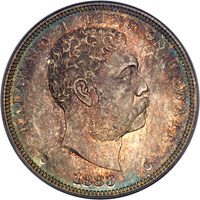 |
1883 Hawaiian Dollar. PCGS graded MS-65 CAC Approved. In a new secure plus holder. Pop 10; 5 finer, 4 in 66, 1 in 67. Lovely golden toning on both sides. Meanwhile, crisp freezing white frost peeks through the toning, mint luster free of disturbance, this special coin shows nice cartwheel effects from the way the metal flowed outward from the center during the coining process. We leave behind the luster much as we�d like to linger and move on to the devices: even the most delicate detail seen on this coin shows that it was made with singular exactness for the issue (PCGS # 10995) .
Estimated Value $13,000 - 15,000.
The Forsythe Collection.
View details and enlarged photos
Check results on similar lots
| Realized
$23,000 |
Lot 1859 |
 |
1883 Hawaiian Dollar. PCGS graded MS-64 CAC Approved. In a new secure plus holder. Pop 20; 16 finer, 1 in 64+, 10 in 65, 4 in 66, 1 in 67. A hint of light gold tone, very nice for the grade. It is always a pleasure for us to be presented with a near Gem quality silver dollar of the Kingdom of Hawaii. Bidders will find they face stiff competition, so come to the sale prepared! Bold, lustrous, and spectacularly original (PCGS # 10995) .
Estimated Value $4,000 - 5,000.
The Forsythe Collection.
View details and enlarged photos
Check results on similar lots
| Realized
$11,500 |
Lot 1860 |
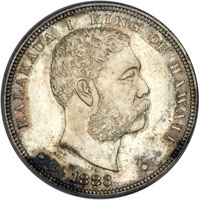 |
1883 Hawaiian Dollar. PCGS graded MS-64 CAC Approved. In a new secure plus holder. Pop 20; 16 finer, 1 in 64+, 10 in 65, 4 in 66, 1 in 67. Some staining near the obverse rims. Nice rainbow toning on the reverse. Bold throughout, the luster from below projects the colorful array into your field of vision in the most opportune way! (PCGS # 10995) .
Estimated Value $4,000 - 4,500.
The Forsythe Collection.
View details and enlarged photos
Check results on similar lots
| Realized
$10,638 |
Lot 1861 |
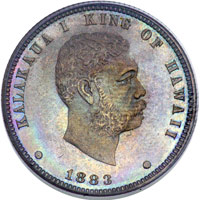 |
1883 Hawaiian Eighth Dollar Copper Pattern. . Medcalf-Russell 2CPC-1. PCGS graded Proof 67 Brown CAC Approved. In a new secure plus holder. Pop 1; none finer at PCGS. The second finest known. The finest is a PF67RB example. Lovely shades of brown colors which blend effortlessly into wonderful blue toning on both sides a most exquisite coin and sure to delight any sophisticated buyer. It is hard to imagine how this coin survived the vicissitudes of time so well as this superb specimen has. The coin is extraordinary in terms of its technical excellence and also for sheer aesthetic beauty.
Humorous anecdote: According to Kuykendall, the most famous historian of the Hawaiian Islands, late in the 1880s, Hawaii's King Kalakaua decided (with the support of his ministers) to form a royal navy in an attempt to forge an alliance of the Polynesian archipelagos which had eluded outright colonization up to that time. This effort culminated in the deployment of the Kaimiloa, the only vessel of the short-lived navy of Kalakaua. Imagine the Keystone Cops and you get an indication of how well this venture fared.
In 1886, the Hawaiian government purchased for $20,000 a 171 ton former British steamer Explorer, "engaged in the copra and guano trade," Renamed Kaimiloa ("the far seeker"), repaired, refitted, and armed with six small brass cannons and two Gatling guns, the little steamer was placed in commission in March 1887, "for the naval service of the Kingdom." The ship was put under the command of Captain George E. Gresley Jackson, who was the principal of the Industrial and Reformatory School, and two dozen of the older boys in that institution were placed on the Kaimiloa to be trained as seamen. "A nucleus of experienced seamen was added to the complement of the ship together with a detachment of marines recruited from the King's Guard. Of the officers, only Captain Jackson had good technical qualifications, and his were heavily discounted by his devotion to John Barleycorn." [Meaning that Jackson was a drunk.]
(Anything further about the misadventures of the Kaimiloa in Samoa that year and later we'll leave to the readers' imagination or to a search on the word "Kaimiloa" on Wikipedia.) (PCGS # 10984) .
Estimated Value $25,000 - 30,000.
The Forsythe Collection.
View details and enlarged photos
Check results on similar lots
| Realized
$46,000 |
Lot 1862 |
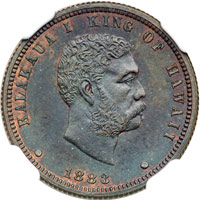 |
1883 Hawaiian Eighth Dollar KM-4A. NGC graded Proof 65 Brown CAC Approved. Lovely brown toning with some mint red visible. No Hapawalu coins were struck for circulation, intensifying collector pressure on the few Proofs and choice copper Pattern pieces which still exist. All have been eagerly sought by collectors for well over a century. This lovely Proof Pattern hapawalu denomination is very seldom seen at auction, let alone in Gem Proof quality, and it is a wonder even a single Proof 65 has survived. The present coin's auction appearance provides an historic opportunity for individuals who want to acquire the finest Hawaiian coins, an opportunity that may not recur for decades to come. Pop 1; 1 finer in PF66BN.
Historic note: Until 1884, even after the Kalakaua coins entered circulation, coins of all descriptions were taken and no word said, "no growl raised," as one supporter stated, although everyone knew the coins value was only 75 cents to 84 cents on the dollar whether they be French, Bolivian, Chile and other South American coins, all of which circulated in the Islands. Then, all at once, with passage by the Hawaiian legislature of the Gold Law of 1884, it was suddenly discovered that U.S. gold coin was the only standard. Just the same, the Kalakaua silver turned out to be well liked, as indicated by the many worn pieces seen today in dealer�s coin trays (they coins circulated between 1884 and 1904 before being demonetized).
Estimated Value $20,000 - 25,000.
The Forsythe Collection.
View details and enlarged photos
| Realized
$33,350 |
Lot 1863 |
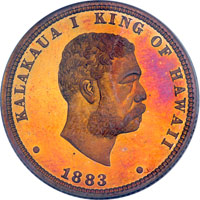 |
1883 Hawaiian Quarter Dollar. PCGS graded Proof 66 Red & Brown CAC Approved. In a new secure plus holder. Pop 1; none finer at PCGS. The finest known example. Only 18 struck. Ex Dagget and our September 2009 sale. A blazing red and brown gem of the finest order with extensive red to fire-gold hues on both surfaces. The brilliant orange centers give way ever so grudgingly to deepening shades of red near the rims and include a subtlety of lilac-rose. Soft-edged devices and lettering throughout the centers are never, ever found on Proof Patterns on this issue. All are needle-sharp and keen-edged, as seen here; with production so low, it might take decades to find another example this spectacular -- if it even exists! (We doubt it exists. All things point to this specimen being the Finest Known. Certainly it is the highest graded.) Identifiers include two tiny toning dots on the obverse, once in the field below the neck truncation, the other in the hair directly above the top of the ear. What seems a miracle to us is that our consignor even found it since coins of this caliber, of this stature, tend to be locked away in famous "name" collections and passed down from father to son, rarely to see the light of day. Act boldly with your bids! (PCGS #509652)
Please excuse us if we take a short detour down memory lane to append this (admittedly lengthy) discussion of the origin of this remarkable twosome (with the 1883 Pattern half dollar) of ex Dagget Hawaiian copper Patterns. The first owner, a Mr. John Daggett, one-time superintendent of the San Francisco Mint, is also the man responsible for having had struck the 24 1894-S Barber dimes! According to Coinfacts.com's website: "In 1972, coin journalist James Johnson, attempted a complete accounting of the 1894-S story. After the article ran in Coin World Collector's Clearinghouse (9/13/72), he received a letter from Guy Chapman of California. Chapman wrote that he had been shown two of the dimes in 1954 by California dealer Earl Parker, just after Parker had acquired them from Hallie Daggett, daughter of the San Francisco Mint superintendent John Daggett. Ms. Daggett told Parker that her father had minted 24 S-mint 1894 dimes as a special request for some visiting bankers. According to her account, Daggett struck the 24 pieces and presented three coins each to seven people. The remaining three, he gave to Hallie, telling her to "put them away until she was as old as he was, at which time she would be able to sell them for a good price." (Breen) As the story goes, Hallie immediately proceeded to spend one of the dimes on ice cream, but kept the other two until she sold them to Parker."
"Today, most experts accept the "made for banker friends" theory as the more likely one. Further evidence is in the fact that all seven of the remaining high grade coins seem to be proof strikes, made from specially-prepared dies and were carefully struck. It's quite unlikely that such care would be taken simply to "round out the books," but the process is logical for such purposes as presentation to bankers."
How does a story about the 1894-S dimes relate to the top-graded Hawaiian copper Proofs we are offering in this sale? A set of four Hawaiian Patterns in copper originated from the same source, San Francisco Mint superintendent John Daggett (1893-97); later, to his daughter Hallie Daggett, the girl who bought ice cream with an 1894-S dime! (to the coin dealer Earle Parker, from whom Hawaiiana specialist Gordon Medcalf, purchased it in 1961). At some unknown time, Gordon Medcalf sold the set to another Hawaiian specialist and collector Ronald Russell (who co-authored the standard guide to Hawaiian coins with Gordon's son, Don Medcalf). It later was acquired intact and sold in September, 2009, by our firm as individual lots.
Estimated Value $30,000 - 35,000.
The Forsythe Collection. Ex: John Daggett (Superintendent, San Francisco Mint 1893-97) as part of a complete 4-piece copper Pattern set; Hallie Daggett (John Daggett's daughter); Earl Parker; sold to Gordon Medcalf, 1961; Sold to Al Ostheimer; Superior Auction Feb 1975 Lot 1540;Ronald Russell;; Ira & Larry Goldberg Auctioneers 9/2009.
View details and enlarged photos
| Realized
$42,550 |
Lot 1864 |
 |
1883 Hawaiian Pattern Quarter Dollar. . Medcalf-Russell 2CPC-2. PCGS graded Proof 65 Brown CAC Approved. In a new secure plus holder. Pop 1; none finer at PCGS in Brown. Even brown toning. A nice bold strike. Only 18 copper Pattern Proof sets were struck. A quite impressive Gem Proof in this elevated grade, with the finest detail sharply displayed since Pattern Proofs in copper were struck from the same dies as the regular silver Hawaiian Proofs; variegated layers of toning envelop the surface on both sides in a warm embrace, including some very attractive iridescent shades on a base of deep reddish-brown. No marks or other indications of contact matter a lot on these rare Proofs, and so go a long way in establishing the grade. (PCGS #10990).
Estimated Value $15,000 - 17,000.
The Forsythe Collection.
View details and enlarged photos
| Realized
$17,250 |
Lot 1865 |
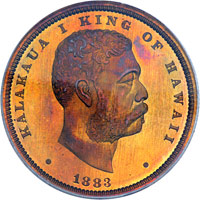 |
1883 Hawaiian Pattern Half Dollar M-2CPC-3 Copper. . Medcalf-Russell 2CPC-3. NGC graded Proof 67+ Star RB CAC Approved. The finest known. Lovely shades of red colors. Pop 1; none finer at NGC. The only example graded at this service in red & brown.
A wonderful red and brown example. 18 struck. Ex Dagget and our September 2009 sale. Magnificent fiery red to golden toning dominates both sides of this spectacular Gem. Identifiers include a tiny toning dot in the hair in line with the upright of the I in KALAKAUA I, also another micro-dot below the truncation near the left side. When carefully viewed at all angles, the full-mirror fields are seen to glisten with a watery effect while an array of subtle amber, rose, and lilac-red hues are revealed. Owing to a razor-sharp strike, the powerfully imparted details are vivid even under the strongest, most revealing magnifying glass. The undisputed rarity of this issue explains why examples seldom come on the market, even in low Proof grades. In fact, this specimen represents the Finest appearance of a copper pattern Proof half dollar -- evidence that it is a once-in-a-lifetime opportunity and the finest example to be auctioned by our firm since its inception! Pop 1; the only red & brown example graded at NGC.
The obverse of all the Hawaiian coins of 1883 is the same and features a head of King Kalakaua facing right. The half dollar has on its reverse the arms without the mantle seen on the one dollar. The legend is the same, but instead of 1 is the fraction one-half, and below, HAPALUA, signifying half-dollar. The eight stripes in quarters 1 and 4 of the shield refer to the eight inhabited islands at the time of issue. (Kahoolawe has since been put off-limits by the U.S. government due to its former use as a bombing range by the military after WWII and lately as a protected nature reserve -- irony of ironies! -- with unexploded ordnance still scattered around the site. The privately owned island of Niihau known to the locals as "The Forbidden Island" restricts visitors.).
Estimated Value $35,000 - 40,000.
The Forsythe Collection. Ex: John Daggett (Superintendent, San Francisco Mint 1893-97) as part of a complete 4-piece copper Pattern set; Hallie Daggett (John Daggett's daughter); Earl Parker; sold to Gordon Medcalf, 1961; Sold to Al Ostheimer; Superior Auction Feb 1975 Lot 1540;Ronald Russell; Ira & Larry Goldberg Auctioneers 9/2009.
View details and enlarged photos
| Realized
$48,300 |
Lot 1866 |
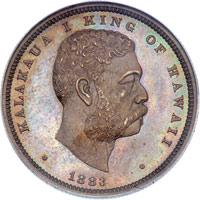 |
1883 Hawaiian Half Dollar. . Medcalf-Russell 2CPC-3. PCGS graded Proof 66 Brown CAC Approved. In a new secure plus holder. Pop 1; none finer at PCGS. Second finest known. Lovely brown toning. A typically bold red and brown Pattern half dollar, one of only 18 struck. Illustrating the near superb quality is sleek reddish to brown toning that governs both sides of this spectacular Gem immersing it in natural beauty. When viewed beneath magnification the subtle reflective fields are seen to ripple with a watery effect while an array of natural copper tints are revealed. A razor-sharp strike is the rule with Hawaiian Patterns and this half dollar shows full details, vivid with three-dimension "depth" even under the glare of the most analytical numismatist�s eye. The rarity of this issue explains why samples rarely surface; even low Proof grades are sparse in the auction records. In fact, this specimen represents the Finest appearance of a copper pattern Proof Half Dollar graded by PCGS -- evidence that it is a prime opportunity for the well-placed buyer. PCGS # 10994.
Estimated Value $25,000 - 30,000.
The Forsythe Collection.
View details and enlarged photos
| Realized
$40,250 |
Lot 1867 |
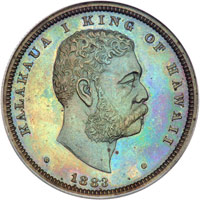 |
1883 Hawaiian Half Dollar. . Medcalf-Russell 2CPC-3. PCGS graded Proof 65 Brown CAC Approved. In a new secure plus holder. 18 pieces struck. A sleek warm brown base coin features lovely iridescent accents of color and with strong underlying reflective luster plus richly detailed highlights on both sides. Razor-sharp, as expected, indeed fully struck and with a partial knife-edge or "fin" (the term used by the Mint). A Proof pattern coin that gets honorable mention where fullness of design is concerned and low population is a key determinant of value. One of several Hawaiian copper Patterns featured in this incredible collection of Hawaiian coins!
All pattern trial pieces were dated 1883 and struck in copper from the same dies used for the 1883 Kingdom of Hawaii silver coins. Eighteen sets (without the umi keneta or dime) were struck in copper. When approved, all denominations were struck in silver Proof, with the dime eventually adopted in place of the eighth dollar so that the Hawaiian coins would match their U.S. silver coin counterparts. (U.S. coins also circulated in the Islands.) Pop 1; 1 finer in 66BN. Lovely green and lilac toning. (PCGS # 10994).
Estimated Value $20,000 - 25,000.
The Forsythe Collection.
View details and enlarged photos
| Unsold |
Lot 1868 |
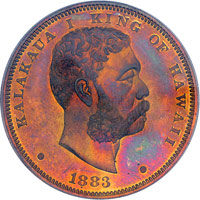 |
1883 Hawaiian Dollar. . Medcalf-Russell 2CPC-4. PCGS graded Proof 66 Red & Brown CAC Approved. In a new secure plus holder. Pop 1; none finer at PCGS. The finest known. Wonderful shades of red and brown colors.
This amazing Dollar�s beautiful fiery golden red cameo devices seem to float over the essentially flawless deep liquid-molten gold fields. A few subtle hairlines are seen in the obverse field, but these are of no consequence where the majestic eye appeal is concerned. The gleaming coppery fields offer delicate contrast with a hint of toning that overlays the entire surface both obverse and reverse. Identifiers are few, but we note a small toning dot below the third A in KALAKAUA's name, another little dot above the circular typographic "stop" to the right of the date. Blushes of lovely pale magenta and blue on either side of the crown on reverse.
The larger diameter of the one-dollar denomination allowed the mint the luxury of placing the entire royal coat of arms and supporters on the piece. The reverse features an elaborate ermine mantle. Over the years, strong growth of interest in Hawaiiana collecting has driven the interest in such pieces to heights unimagined by collectors and coin dealers of a few decades ago when these were more or less relegated to the backwaters of American numismatics.
Only the one Proof copper dollar has been graded by PCGS at this level (see below) which means that bidders have a fair shot at owning what has to be the Finest Known copper pattern dollar of the Kingdom of Hawaii. This specimen is truly spectacular. It is perfectly possible for the present glittering Proof to become the centerpiece in a collection of Hawaiian coins. Pop 1; the only example graded in PR66 RB at PCGS.
Kalakaua I, born David La'amea Kamanakapu'u Mahinulani Nalaiaehuokalani Lumialani Kalakaua and sometimes called The Merrie Monarch (November 16, 1836 - January 20, 1891), was the last reigning king of the Kingdom of Hawaii. He served in office from February 12, 1874 until his death at the Palace Hotel in San Francisco, California, on January 20, 1891.
When King Kamehameha V, the last monarch of the Kamehameha dynasty, died on December 12, 1872 without naming a successor to the throne several candidates arose, including William C. Lunalilo and Kalakaua. Lunalilo was the more popular of the two while Kalakaua was much more conservative than his main opponent, Lunalilo.
On January 1, 1873, a popular election was held for the office of King of Hawaii. Lunalilo won with an overwhelming majority. The next day, the legislature confirmed the popular vote and elected Lunalilo unanimously. Kalakaua conceded.
However, barely a year later, Lunalilo died on February 3, 1874. (King Lunalilo did not enjoy good health during his reign. He had some bad health habits; for example, he was an alcoholic like many of the Hawaiian kings.) With his death, Kalakaua was elected to replace him, supported by the legislature although many of the populace, mainly the native Hawaiian and British subjects in the Kingdom, preferred Queen Dowager Emma, who stood against him.
Upon ascending the throne, Kalakaua named his brother, William Pitt Leleiohoku, as his heir, putting an end to the era of elected kings in Hawaii. Among many other things, his famous coinage keeps his memory alive with the people of Hawaii and coin collectors here in the U.S. and worldwide.
Note: So significant was the pending issuance of coinage for the Kingdom of Hawaii, even before the coins were made, the October 1883 issue of "The American Journal of Numismatics" had this summary of Kalakaua�s coinage before it was known that a dime-sized coin was to be substituted for the eighth-dollar denomination:
KALAKAUA I, the King of the Hawaiian Islands, has recently had dies prepared for striking silver coins for his realm, brief allusion to which was made in the last number of the Journal. These dies were executed at Philadelphia, under the direction of the Mint authorities, and the money is to be struck by permission of our Government in the Mint at San Francisco. There are to be four denominations Dollars, Halves, Quarters and Eighths bearing substantially the same devices. The Dollar shows on the obverse the naked bust of the King to observer's right, surrounded by the legend, KALAKAUA I KING OF HAWAII, and the date, 1883, at the bottom. It is said by those who have seen the coins, that "the profile head of the King compares favorably with that of many rulers of much more important countries," and that " the coinage itself, in beauty of design and character of workmanship, is quite equal to that of many of the older nations of Europe." Whether this be a correct judgment we can better determine hereafter. On the reverse will be seen blazoned the royal arms. The shield is displayed on a mantle, which, in an engraving of the piece we have seen, seems to be ermine. The national "mantle," however, in the arms, is properly the famous feather cloak, such as was worn by Kamehameha the Great, and his chiefs, in the ancient and prosperous days of the islands, and which forms the "royal robe" of the present king on State occasions; above the shield is the royal crown. PCGS Certification # 509658.
Estimated Value $80,000 - 90,000.
The Forsythe Collection.
View details and enlarged photos
| Unsold |
Lot 1869 |
 |
1928 Hawaiian Half Dollar. PCGS graded MS-65+. In a new secure plus holder. Pop 1; 75 finer, 70 in 66, 3 in 66+, 2 in 67. Mostly untoned. A satiny gem. Graceful underlying luster supports pale unevenly distributed gold toning. A pleasing example of the Commemorative which was issued for the 150th anniversary of Captain Cook�s "discovery" (for Europeans, anyway) of the Hawaiian archipelago. Nicely struck, and with excellent detail in hair and jacket, similar fine detail carrying over to the High Chief (no one in particular, just a generic representation of a typical Royal politician of the day).
At the time Cook visited the islands in 1778-79, there were 8 inhabited islands. The Big Island, most southerly of the eight, was split between rival tribes and was the birthplace of the later King Kamehameha, who was but a young man when Cook arrived. Islands other than the Big Island were individually controlled or sometimes two or more were associated under one chief. As always in politico-monarchial hierarchies, rivalries were rampant, wars brief but intense, life for the commoners "solitary, poor, nasty, brutish, and short", Territories changed hands constantly. It wasn�t until, over a 25 year period, that Kamehameha the First finally consolidated power throughout the islands. 1810 is the closing year of this episode, the final holdout being Kauai, whose ruler King Kaumualii pledged allegiance to Kamehameha rather than face an invasion. For the most part, thereafter, peace descended like a welcome gift from the gods upon the Hawaiian populace after 500 years or more of contentiousness (PCGS # 9309) .
Estimated Value $3,300 - 3,500.
The Forsythe Collection.
View details and enlarged photos
Check results on similar lots
| Realized
$4,025 |
Lot 1870 |
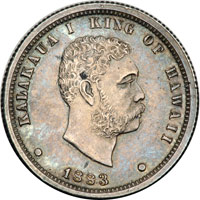 |
1883 Hawaiian 12½ Cent Struck In Silver 4 Grams. Our grade is MS63. Sent to NGC and PCGS with Questionable Authenticity. Sold as is.
In their request to have coins struck by the United States government, the Hawaii government included four denominations: a 1/8th Dollar (Hapawalu), a 1/4 Dollar (Hapaha), a 1/2 Dollar (Hapalua), and a Dollar (Akahi Dala). All of the denominations, except the 1/8th Dollar, conformed to American coins in size, weight and value. Because the Hapawalu would have required specially made blanks, a Dime denomination (Umi Keneta) was substituted for the Hapawalu. No Hapawalus were struck for circulation, but when 20 special presentation Proof sets were made at the Philadelphia (PA) Mint in 1884, Hapawalus were included along with the other four denominations.
Some time after the fact, a person or persons unknown, using dies similar to the official government dies but with "lazy 8s" in the date, struck an unknown number of Hapawalu pieces d�caprice from said dies. These were not authorized by the Hawaiian government, nor were they struck in 1883 (or 1884 for the companion gold and platinum private mintings.) All the same, for years, such pieces have captured the fancy of collectors far and wide, and have been collected right along with the others who are drawn to this small island paradise, two and a half thousand miles off the coast of North America.
Estimated Value $1,000-UP.
The Forsythe Collection.
View details and enlarged photos
| Realized
$3,449 |
Lot 1871 |
 |
1884 Hawaiian Quarter Dollar Struck In Gold 8.35 Grams. PCGS graded MS-66. "1884" (c. 1900) On the holder Hawaii (fantasy) strike hub impression. Companion piece to the 1884 "Half Dollar" struck in gold, and associated with the similarly obscure in origin 1883 strikes in platinum, copper and other metals. All areas of numismatics abound in curiosities. Whatever country you choose, if you delve deeply enough into the subject you will feel as Alice�s did when she followed the rabbit into his hole. You will discover a Wonderland of mystery and obscure items. Sometime possibly in the early 20th century, a person unknown had made some simulated dies which mimicked the official Hawaiian coins of 1883. Some are dated 1883, others are 1884. Per Don Medcalf�s Hawaiian Money Standard Guide, we quote the applicable section:
"The following were not authorized by the Hawaiian Government, nor were they struck in 1883 or 1884; eighth dollar (with "lazy eights") in copper, nickel, bronze, gold and platinum -- 1884 quarter dollar in bronze, oroide, gold and platinum -- 1884 half dollar in bronze, gold, copper and platinum. The genuine eighth dollar copper pattern, 2PC-1, has "regular eights" and the unauthorized issue the "lazy eights." PCGS # 510970.
Estimated Value $15,000-UP.
Ex: Palace Sale King Farouk 1954 Lot 110; The Forsythe Collection.
View details and enlarged photos
| Realized
$20,400 |
Lot 1872 |
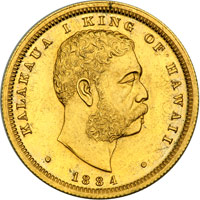 |
1884 Hawaiian Half Dollar Struck In Gold 16.68 Grams. PCGS graded MS-66. "1884" (c. 1900) On the holder Hawaii (fantasy) strike hub impression half dollar. No doubt from the same issuer as the other gold and platinum strikes whose history is clouded in mystery. It is likely those who know their origin and now long since departed died with their lips sealed as to who the clever individual was that had these made.
The 1884 half dollar appeared with others of this description in a Heritage 2000 FUN sale and trace all the way to the renowned King Farouk sale of 1954. Before that, the scent runs cold and a veil of uncertainty closes in on our understanding of whence, how, and by whom these marvelous items came to be. Likeness similar to the official Medcalf-2CS.4, the obverse has a head of King Kalakaua I facing right and the reverse has crowned and mantled arms, dividing ½ and DOL, with HAPALUA below. Uncirculated with slightly granular surfaces as also found on the quarter dollar in gold and the platinum strikes. Again, these pieces are unofficial issues, probably struck at a later date, possibly, Ex: The Palace Collections of Egypt (the King Farouk sale), lot 110. Two or three pieces of each are known in gold. None of the gold or platinum strikes have appeared at auction for quite some time.
Estimated Value $15,000-UP.
Ex: Palace Sale King Farouk 1954 Lot 110; The Forsythe Collection.
View details and enlarged photos
| Unsold |
Lot 1873 |
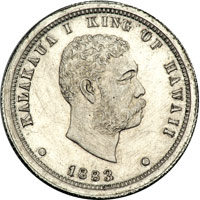 |
1883 Hawaiian 12½ Cent Struck In Platinum 7.29 Grams. PCGS graded MS-65. "1883" (c. 1900) On the holder Hawaii (fantasy) strike hub impression eighth dollar with lazy 8s with a format that imitates Medcalf-2CS.2, the obverse has a head of King Kalakaua I facing right and the reverse has HAPAWALU within a wreath, with EIGHTH DOL. below; Uncirculated with slightly granular surfaces. Originally part of a set of three platinum pieces (with the Quarter and Half Dollar), all are unofficial issues, probably struck at a later date, possibly Ex: The Palace Collections of Egypt (the King Farouk sale), lots 1502, 1503, and 1504. The Farouk sale catalog calls all three pieces unique, but there may be two or three pieces known of each. PCGS # 510972.
Estimated Value $15,000-UP.
Ex: Palace Sale King Farouk 1954 Lot 1504; The Forsythe Collection.
View details and enlarged photos
| Unsold |
Lot 1874 |
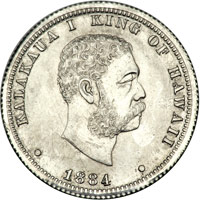 |
1884 Hawaiian Quarter Dollar Struck In Platinum 11.48 Grams. PCGS graded MS-64. "1884" (c. 1900) On the holder Hawaii (fantasy) strike hub impression quarter dollar, similar to Medcalf-2CS.3, the obverse has a head of King Kalakaua I facing right and the reverse has crowned arms dividing ¼ and D, with HAPAHA below; Uncirculated with slightly granular surfaces as seen on all types and denominations. These are unofficial strikes, probably struck at a later date, possibly Ex: The Palace Collections of Egypt (the King Farouk sale), lots 1502, 1503, and 1504. The Farouk sale catalog calls all three pieces unique, but there may be two or three pieces known of each. PCGS # 510971.
Estimated Value $15,000-UP.
Ex: Palace Sale King Farouk 1954 Lot 1503; The Forsythe Collection.
View details and enlarged photos
| Unsold |
Lot 1875 |
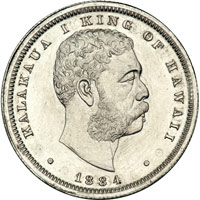 |
1884 Hawaiian Half Dollar Struck In Platinum 17.77 Grams. PCGS graded MS-66. "1884" (c. 1900) On the holder Hawaii (fantasy) strike hub impression half dollar, companion piece to the platinum quarter dollar in this sale, similar to Medcalf-2CS.4, the obverse has a head of King Kalakaua I facing right and the reverse has crowned arms dividing 1/2 and D, with HAPALUA below; Uncirculated with slightly granular surfaces as seen on all types and denominations. These are unofficial strikes, probably struck at a later date, possibly Ex: The Palace Collections of Egypt (the King Farouk sale), lots 1502, 1503, and 1504. The Farouk sale catalog calls all three pieces unique, but there may be two or three pieces known of each. PCGS # 510969.
Estimated Value $15,000-UP.
Ex: Palace Sale King Farouk 1954 Lot 1502; The Forsythe Collection.
View details and enlarged photos
| Unsold |
Lot 1876 |
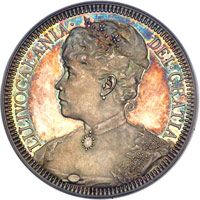 |
1891 (93) Hawaii Dollar Bruce X-M1-Akahi Dala. . Medcalf-Russell 2MH-1. PCGS graded Proof 65+ CAM, CAC Approved. In a new secure plus holder. Pop 1; none finer at PCGS. Plain edge. Silver. Lovely blue and golden toning. The finest known. The obverse features a mature, but still youthful looking Queen Liliuokalani (1838-1917), facing left. A map of the Hawaiian Islands set in the frosted globe background of the Pacific Ocean provide the focus for the reverse. Liliuokalani was deposed in January 1893 in a bloodless coup by a group of American businessmen and bankers and, despite several years of appeals to the United States and imprisonment in her private residence, Washington Place, a block from the palace, the Queen never regained her throne. Hawaii went through several transitions before gaining Territorial status: that of a Provisional Government (1893-94), Republic (1894-99), annexation occurred in 1898, but full Territorial status wasn't achieved until 1900.
Several of Liliuokalani's musical compositions are enjoyed by Hawaiians to this day as mentioned elsewhere in the sale. A mere 50 pieces of these beautifully designed Liliuokalani Huth $1 issues are believed to have been struck. This piece is accented in iridescent shades as described above, with just a few minor hairlines visible under magnification. Huth $1 coins of any category or grade are eagerly sought by both numismatic enthusiasts and collectors of Hawaiiana alike. According to Medcalf, Reginald Huth was a wealthy British coin collector who enlisted Pinches & Co. of London to produce a select quantity of high quality Hawaiian medals in various metals (silver, copper, and gold). We are pleased that Mr. Forsythe accomplished the Herculean task of assembling four distinct specimens, including a unique gold example. (Listed in Medcalf & Russell's Hawaiian Money Standard Catalog, 2nd Edition, 1991 as 2MH-1.) (PCGS # 511638) .
Estimated Value $20,000 - 25,000.
The Forsythe Collection.
View details and enlarged photos
Check results on similar lots
| Realized
$56,350 |
Lot 1877 |
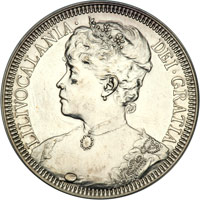 |
1891 (93) MH-1 Reginald Huth $1. . Medcalf-Russell 2MH-1. PCGS graded Proof 60 CAC Approved. In a new secure plus holder. Pop 1; none finer at PCGS. Only 50 struck. A fully white coin. This 37.1mm, plain edge unofficial pattern displays a wealth of elegance from its untoned status. Scrupulous examination finds some hairlining and a few contact marks. This historic piece is one of only 50 Proofs struck and is today a sought-after rarity for seekers of the ultimate in Hawaiiana.
The obverse depicts a coronet bust facing left with Latin title that continues onto the reverse, LILIVOCALANIA DEI GRATIA, HAWAIARVM REGINA. The reverse bears a globe with the Hawaiian Islands above the denomination AKAHI DALA. This obverse was also used on gold 20 Dala patterns bearing crossed torch and scepter.
This Hawaiian $1 denomination is one of a number of beautifully designed pièces de fantaisie created by wealthy English collector Reginald Huth and struck for him by the London medallic firm of John Pinches Ltd. A gentleman of leisure, Huth was fascinated by deposed queens and princesses including Liliuokalani and her niece Princess Kaiulani, in whose name he created silver Dala and gold 20 Dala patterns. Other historical figures honored by him were Madagascar's Queen Ranavalo; Spain's deposed Isabel II and the Queen Regent Maria Cristina; Infanta of Spain Luisa Fernanda, Duchess of Mompensier; and the youthful King Alfonso XIII. Irish patterns of Queen Victoria honored her 1900 visit and Huth created several patterns for King George V. The death of his own mother was marked by a coin-like medal of 1901.
Liliuokalani was born Sept. 2, 1838, near the base of the extinct volcanic crater "Punchbowl" that remains a Honolulu landmark today. Her name in Hawaiian translates "Salt Air of Heaven." Her brothers were King Kalakaua and his designated heir Prince Leleiohoku, who died in 1877. She became reigning Queen on Kalakaua's death on Jan. 20, 1891. She married General John Owen Dominis, whose death on Aug. 27, 1891 deprived her of much needed counsel and support.
The royal government was overthrown by American filibusters led by Sanford B. Dole on Jan. 17, 1893 in a bloodless coup. U.S. President Grover Cleveland held the overthrow to be an act of piracy and refused to annex Dole's newly proclaimed Republic of Hawaii. The islands were finally annexed on Aug. 12, 1898 under the more imperial-minded President William McKinley. Queen Liliuokalani was never restored and died on Nov. 11, 1917.
Huth's patterns for Queen Liliuokalani and her heir Princess Kaiulani (died 1899) are among his most beautiful works and have been diligently sought by collectors for more than a century. The present Dala is certain to become a treasured centerpiece of some great Hawaiian collection. (PCGS #726247).
Estimated Value $12,000 - 15,000.
Ex: Medcalf; The Forsythe Collection.
View details and enlarged photos
| Realized
$16,800 |
Lot 1878 |
 |
1895 Pattern Hawaiian Dollar. . Medcalf-Russell 2MH-3. NGC graded Proof 64 Cameo CAC Approved. Only 20 struck. Lovely gold and blue toning. A tiny obverse scratch by the chin. Deep mirror reflectivenss serves to amplify the colorful aspects of this fascinating (and fascinatingly beautiful) Huth $1. The colors are consistant on both sides and clearly original, no doubt tracing back to this piece�s inception. Nicely mirrored fields show light traces of hairlines, Only 30 examples of this rarity are said to have been coined (50 in all between the single-dolphin and four-dolphin Kaiulani silver dollars). Widely distributed, they rarely surface, making this the rarest of the silver Hawaii Huth patterns as well as arguably the most beautiful, with a single neatly engraved dolphin below the young Princess' head. As noted on the other example in Mr. Forsythe�s group, the date on the reverse commemorates her coming of age on her 18th birthday, October 16, 1893. It is punched in tiny numerals 18 and 95 within the two spheres on the reverse. A distinctive rarity for all specialists of Hawaiiana, U.S.-related, or those whose gamut covers the World -- and a highlight in any cabinet. Pop 1; none finer at NGC.
Estimated Value $15,000 - 18,000.
The Forsythe Collection.
View details and enlarged photos
| Realized
$26,400 |
Lot 1879 |
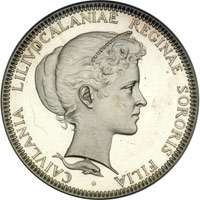 |
1895 MH-3 Reginald Huth Silver ($1). . Medcalf-Russell 2MH-3, one dolphin below bust. PCGS graded Proof 61 Cameo CAC Approved. In a new secure plus holder. Pop 1; none finer at PCGS. Only 20 struck. Untoned with minor hairlines visible. The so-called Princess Kaiulani "Pattern" $1 by Reginald Huth. A wholly brilliant example consistent on both sides and carefully minted to show all the finest devices in microscopic detail. Mirrored fields show light traces of handling, a few nicks are insignificant. Only 50 examples (combined mintage 2MH-3 & 2MH-5 combined) of this rarity are said to have been coined and distributed, making this the rarest of the silver Hawaii Huth $1 pieces as well as arguably the most delightful as it depicts the Heir to the throne whose sudden death at the age of 23 while on a visit to England caused heart-rendering sadness throughout the Kingdom. The date on the reverse commemorates Kaiulani�s coming of age on her 18th birthday, October 16, 1893. A landmark rarity for Hawaii specialists and a highlight in any cabinet. (The pattern was not issued until 1895.).
Estimated Value $12,000 - 15,000.
The Forsythe Collection.
View details and enlarged photos
| Realized
$18,400 |
Lot 1880 |
 |
1895 Hawaiian FR-7 Reginald Huth Gold ($20). PCGS graded Proof 63 Cameo CAC Approved. In a new secure plus holder. Pop 1; none finer at PCGS. We believe only 2 are known. This example and one in the Smithsonian. Four dolphins flank the portrait of Princess Kaiulani (1875-99) on this imposing gold issue by Reginald Huth.
Struck in gold with a weight that of a contemporary U.S. $20 gold piece, the piece is graded by PCGS Proof 63 Cameo. The obverse features a head of the Princess along with four dolphins in the nearby field. The reverse depicts a globe centered on the Hawaiian Islands and bears the date October 16, 1893 (which was the eighteenth birthday of the Princess). In tiny numerals, the date 18 95 appear in the two circles or typographic stops at either side of the globe for the year of issue. Kingdom of Hawaii specialists will recognize it as type of MH-5 (but with no Medcalf-Russell catalog number).
Technically neither a $20 gold piece nor a pattern, the 1895 Huth pieces are nonetheless coveted by Hawaiian specialists. According to Medcalf, "They are extremely popular and seldom offered for sale." This specimen of the $20 gold 1895 issue is the only one available for purchase; the other example known resides in the Smithsonian�s collection.
These fascinating high quality medals were struck by Messrs. Pinches & Co. of London, England. They were made to order for Reginald Huth, a wealthy English numismatist and royalist who made similar unofficial pieces for Spain, Madagascar, and England. It is noted by Medcalf that after minting the Hawaiian issue, the dies of these were reputedly destroyed.
Princess Kaiulani, whose full name was Victoria Kawekiu Lunalilo Kaianinuiahiiapaiapa Kaiulani was the final heir to the Hawaiian throne. Her visit to President Grover Cleveland is credited with his decision to deny annexing the Hawaiian Islands, although President McKinley annexed Hawaii in 1898, ending the Monarchy and short-lived Republic.
This Kaiulani Huth $20 gold is the grand prize of Hawaiian numismatics, seldom offered and especially desirable for being struck in gold. Listed in Friedberg under Hawaii F-7 Gold Coins Of The World.
Reginald Huth (1853-1926) was himself an auction consignor, or at least his estate was, selling his coin collection through Sotheby's in April and June 1927. It has been said that his fear of germs led him to wash all of his coins before placing them in his cabinet, which may have affected their later market performance considerably according to one commentator. This small group of Hawaiian Huth medals comes to us from Gerald Forsythe, a long-time specialist in Hawaiiana who, in this sale, has consigned multiple silver issues and this illustrious Kaiulani gold $20.
Estimated Value $200,000 - 250,000.
Ex: Ostheimer Collection; Edwards H. Metcalf Sale Lot 1527 February 1975 Auction $36,000; The Forsythe Collection.
View details and enlarged photos
| Realized
$230,000 |
|
|